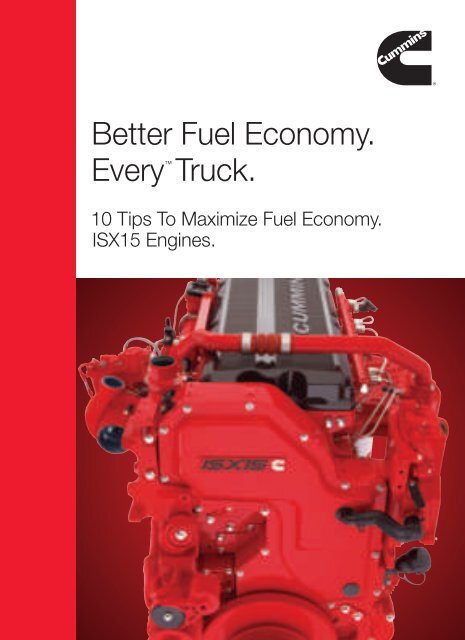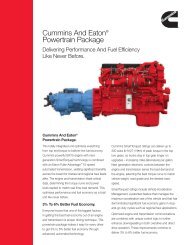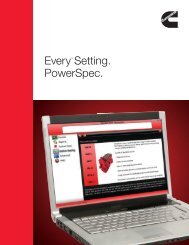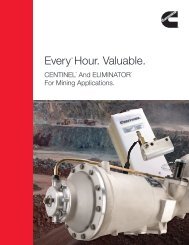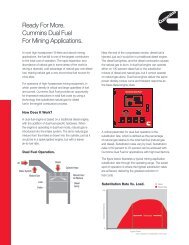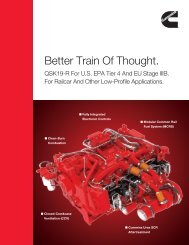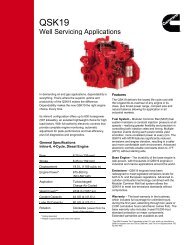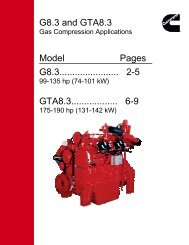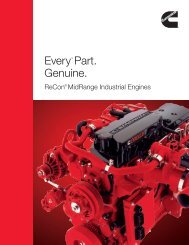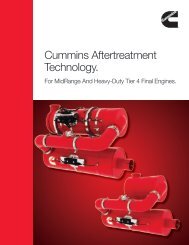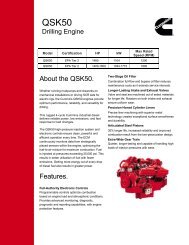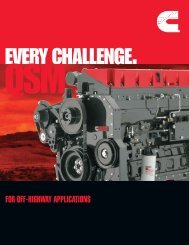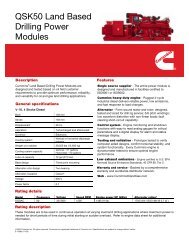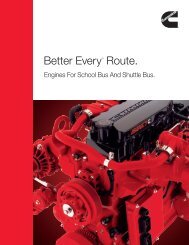Better Fuel Economy. Every™ Truck. - Cummins Engines
Better Fuel Economy. Every™ Truck. - Cummins Engines
Better Fuel Economy. Every™ Truck. - Cummins Engines
You also want an ePaper? Increase the reach of your titles
YUMPU automatically turns print PDFs into web optimized ePapers that Google loves.
<strong>Better</strong> <strong>Fuel</strong> <strong>Economy</strong>.<br />
<br />
Every <strong>Truck</strong>.<br />
10 Tips To Maximize <strong>Fuel</strong> <strong>Economy</strong>.<br />
ISX15 <strong>Engines</strong>.
10 Tips To Maximize <strong>Fuel</strong> <strong>Economy</strong>.<br />
Vehicle Spec’ing.<br />
1. Spec gearing ratios properly.<br />
For long-haul engines up to 450 hp (336 kW), recommended gearing for the ISX15 is<br />
1370-1450 rpm at 65 mph (104.6 km/h). If less than 1650 torque, gear at 1400 rpm. For<br />
1650+, gear at 1370 rpm at 65 mph (104.6 km/h). (See your <strong>Cummins</strong> rep for optimal ratio.)<br />
For ISX15 engines 450 hp (336 kW) and above, recommended gearing is 1400-1430 rpm<br />
at 65 mph (104.6 km/h).<br />
2. Spec advanced aerodynamics.<br />
An aerodynamic truck-and-trailer configuration versus a non-aerodynamic configuration can<br />
result in a fuel economy improvement of approximately 13%.<br />
Driving Habits.<br />
3. Lower drive speeds.<br />
At interstate speeds, each 1.0 mph (1.6 kph) increase = 0.1 mpg (0.04 km/L) loss.<br />
For example, driving at 65 mph instead of 75 mph can save 1 mpg (0.43 km/L).<br />
4. Run in top gear more than 90% of the time.<br />
Every 10% drop of time in top gear = 0.5% mpg (0.22 km/L) loss.<br />
5. Turn on Load-Based Speed Control (LBSC).<br />
Using LBSC with aggressive settings of 1600 rpm can save as much as 3% in fuel.<br />
6. Decrease idle rpm and idling time.<br />
Using the lowest idle speed possible helps reduce fuel use by up to 0.5 gal/hr (1.89 L/hr). Every<br />
hour of idle time that you eliminate can raise your vehicle’s fuel economy by as much as 1%.<br />
7. Follow proper driving habits.<br />
Sudden braking, rapid acceleration, downshifting too early and other poor driving habits can<br />
negatively impact fuel economy by as much as 30%. Following proper driving techniques is<br />
critical to maximizing fuel economy.<br />
Measuring <strong>Fuel</strong> <strong>Economy</strong>.<br />
8. Run 50,000 miles (80,467 km) before measuring fuel economy.<br />
Early results are not an accurate representation. Tire break-in and effects of first fill can skew<br />
the results.
9. Adjust for seasonal variations.<br />
Seasonal fluctuations from winter to summer can account for a gain of 8% to 12% in fuel<br />
economy. A comparable decrease happens when going from hot weather back to colder<br />
temperatures.<br />
Vehicle Maintenance.<br />
10. Tires and maintenance are critical.<br />
Tire tread and casing design can account for 12% difference in fuel economy. Proper<br />
chassis alignment and tire inflation are critical to getting better fuel economy.<br />
Key Electronic Features And Parameters<br />
That Optimize <strong>Fuel</strong> <strong>Economy</strong>.<br />
Load-Based Speed Control.<br />
LBSC is a <strong>Cummins</strong>-exclusive feature that limits the engine rpm when not needed – to save<br />
fuel and reduce driveline wear. When needed, LBSC will allow the engine to operate at the full<br />
governed speed when operating with heavy loads and/or on moderate grades, or when making<br />
gear changes. LBSC encourages proper driving techniques and improves fuel economy.<br />
Gear-Down Protection (GDP).<br />
GDP helps maximize running the transmission in top gear. This will keep the engine operating at<br />
lower rpm for better fuel economy and engine life. GDP can be used in conjunction with LBSC to<br />
limit engine operating speeds throughout the vehicle’s entire operating range.<br />
Road Speed Governor (RSG) And Cruise Control.<br />
Setting a lower road speed limit improves fuel economy. Using cruise control to maintain a<br />
desired road speed (eliminating throttle input variance) also improves fuel economy. Road speed<br />
governor can be set independently to encourage cruise control use.<br />
Idle Speed Control.<br />
Lower rpm settings reduce fuel use in all idling situations. Use the lowest idle speed possible.
Front-End Spec’ing.<br />
Each spec’ing option and parameter setting can optimize the fuel economy of new<br />
heavy-duty vehicles.<br />
Spec’ing Option/<br />
Parameter Setting<br />
<strong>Fuel</strong> <strong>Economy</strong> Savings.<br />
Approximate Gain<br />
Aerodynamic truck vs.<br />
non-aerodynamic truck 12%<br />
Differential gearing 3%<br />
Direct transmission vs.<br />
overdrive transmission 3%<br />
<strong>Fuel</strong>-efficient tires vs. standard tires 8%<br />
Load-Based Speed Control usage 3%<br />
Gear-Down Protection usage 3%<br />
Improvement<br />
Savings<br />
6% (6.36 mpg) (2.7 km/L) $5,094/unit/yr.<br />
5% (6.3 mpg) (2.68 km/L) $4,286/unit/yr.<br />
4% (6.24 mpg) (2.65 km/L) $3,462/unit/yr.<br />
3% (6.18 mpg) (2.63 km/L) $2,621/unit/yr.<br />
2% (6.12 mpg) (2.6 km/L) $1,765/unit/yr.<br />
1% (6.06 mpg) (2.58 km/L) $ 891/unit/yr.<br />
Calculated using 6 mpg (2.55 km/L) at $4.50 per gallon ($1.19 per liter).<br />
Annual mileage of 120,000 miles (193,121 km).<br />
<strong>Cummins</strong> Inc.<br />
Box 3005<br />
Columbus, IN 47202-3005<br />
U.S.A.<br />
Phone: 1-800-DIESELS (1-800-343-7357)<br />
Fax: 1-800-232-6393<br />
Internet: cumminsengines.com<br />
Twitter.com/<strong>Cummins</strong><strong>Engines</strong><br />
YouTube.com/<strong>Cummins</strong><strong>Engines</strong><br />
Bulletin 4971341 Printed in U.S.A. Rev. 7/12<br />
©2012 <strong>Cummins</strong> Inc.


